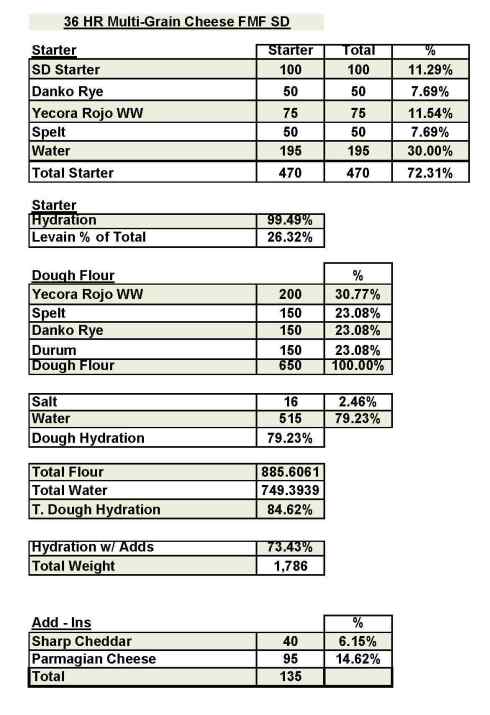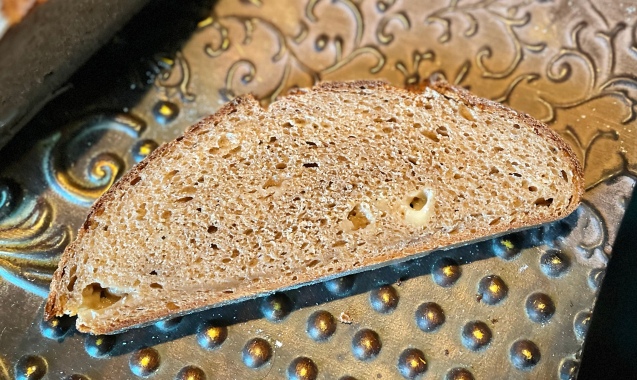I have not made a bread in a long time using this technique which extracts as much flavor as possible from the flour. I wanted to try it using almost 100% fresh milled flour. Their is a tiny little bit in the seed starter but other than that it’s a combination of Barton Springs Mill Danko Rye, Yecora Gold Whole Wheat, Spelt and another companies Durum berries.
Except for the Spelt, the other grains were milled, sifted with a #30 drum sieve, re-milled with my Mockmill 200 with the stones starting to click and sifted again with a #40 drum sieve. The Spelt was milled, sifted with a #30 and then re-milled but not sifted again.
I used some real Parmigiana Reggiano and Vermont extra sharp cheddar cheese both chopped into pieces. Since the cheese was added with the flour with the first mix, the flavor was very pronounced in the baked bread. I might try adding it before the second bulk next time.
The final bread was very tasty with a nice crumb. It was slightly over-proofed as I didn’t get much oven spring and it flattened out considerably after taking it out of it’s banneton. I should not have let it sit out as long as I did after taking it out of the refrigerator after bulk retarding.

Directions
Starter
Mix ingredients in a bowl until thoroughly combined. Cover the bowl and let it sit at room temperature for around 8 hours. The starter should almost double when ready to proceed.
Main Dough
Mix the flours, 465 grams of the water together in your mixer or by hand until it just starts to come together, maybe about 1 minute. Next add the cheese and mix for another minute. Put the dough in a slightly covered oiled bowl and put in the refrigerator for 12 hours.
The next day add your starter, rest of the water (50 grams) and salt to the dough and mix by hand or in your mixer until it is thoroughly mixed and evenly distributed. Due to the high water content in the 100% hydration starter this dough is very easy to mix by hand and is very silky and smooth.
Bulk rise at room temperature for 2 hours until it grows around 1/3 in volume doing stretch and folds every half hour until it has developed the correct amount of strength.
Put the dough back into the refrigerator for around 20-30 hours.
When you take the dough out of the refrigerator you want it to have almost doubled in volume but if it didn’t it should still be fine. (Mine only rose about 1/3 in volume). Let it rise at room temperature for around 2 hours or until the dough has doubled from the night before. (I used my proofer set at 82 degrees for 2 hours but I should have only let it go for about an hour).
Next, shape as desired. Make sure you use enough rice flour with flour in your bowl/basket to prevent this moist dough from sticking.
Cover the dough with a moist towel and let sit at room temperature for 1.5 to 2 hours.
When the dough is ready to bake, score as desired and prepare your oven for baking with steam.
Set your oven for 540 degrees F. at least 45 minutes before ready to bake. When ready to bake place the loaves into your on your oven stone with steam and lower the temperature immediately to 450 degrees. When the loaves are nice and brown and reached an internal temperature of 210 degrees F. you can remove it from the oven.
Let the loaves cool down for at least an 3 hours or so before eating as desired.

ADVERTISEMENT